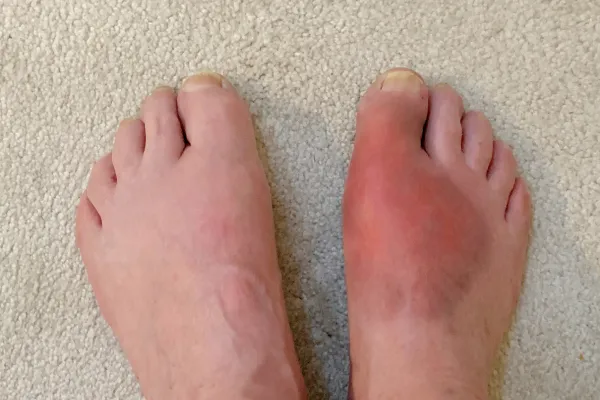
Gout and Foot Pain: Understanding the Link and Podiatric Treatment
Gout is a form of arthritis that causes sudden and severe pain, often affecting the joints in the feet. While it’s commonly associated with the big toe, gout can affect other parts of the body as well. For those experiencing foot pain due to gout, it’s important to understand the link between the condition and the pain it causes, as well as how podiatric treatments can help manage and alleviate discomfort.
In this blog post, we’ll explore what gout is, how it relates to foot pain, and the podiatric treatments available to provide relief.
What Is Gout?
Gout occurs when there is a buildup of uric acid in the blood, which forms crystals that can accumulate in the joints. These crystals cause inflammation and intense pain, typically in the lower extremities. Although gout can affect any joint, it most commonly affects the big toe due to the cooler temperatures in the toes, which encourage the formation of uric acid crystals.
Gout is often referred to as a "disease of kings" because it was historically linked to rich diets high in purines, found in foods like red meat and alcohol. However, anyone can develop gout, and it’s more common in people with certain risk factors such as obesity, high blood pressure, diabetes, and a family history of gout.
The Link Between Gout and Foot Pain
Foot pain due to gout is primarily caused by the formation of uric acid crystals in the joints. These crystals lead to inflammation, swelling, and pain that can be sudden and excruciating. Some of the most common symptoms of gout in the foot include:
Intense pain in the big toe: This is the most common area affected by gout, with pain often starting suddenly, especially at night.
Redness and swelling: The affected area may become visibly swollen, red, and warm to the touch.
Tenderness: Even the lightest touch or pressure on the affected joint can cause severe pain.
Difficulty moving the foot: The stiffness and pain may make it difficult to walk or bear weight on the foot.
When gout strikes, it can limit mobility and significantly affect a person’s daily life. Without proper treatment, flare-ups can become more frequent and last longer, potentially leading to joint damage.
Podiatric Treatment for Gout-Related Foot Pain
While gout itself requires medical management, podiatric care plays a crucial role in managing foot pain and improving mobility during flare-ups. Here are some of the treatments podiatrists use to help individuals with gout-related foot pain:
Medications for Pain Relief
Podiatrists can collaborate with your physician to ensure that you have the right medications for managing gout attacks. Nonsteroidal anti-inflammatory drugs (NSAIDs) are often used to reduce pain and swelling, while colchicine or corticosteroid injections may be recommended for more severe flare-ups.Foot and Joint Immobilization
During an acute gout attack, it’s essential to rest the affected foot and avoid putting weight on the joint. Podiatrists can help by advising on how to keep the joint immobilized, using special foot supports, and offering recommendations on how to alleviate pressure on the foot to allow the inflammation to subside.Custom Orthotics
If gout causes long-term foot pain or misalignment, custom orthotics may be used to help redistribute pressure and provide better support for the affected joints. Orthotics can help prevent further joint damage and improve walking mechanics.Lifestyle and Footwear Recommendations
Proper footwear is crucial for gout sufferers, as ill-fitting shoes can exacerbate foot pain. A podiatrist can recommend shoes with proper arch support and cushioning to protect sensitive joints. Lifestyle changes, including weight management and dietary modifications, are also important to prevent gout flare-ups.Cryotherapy (Cold Therapy)
Applying cold packs or ice to the affected foot can help reduce swelling and relieve pain during a gout attack. A podiatrist can provide guidance on how to use cryotherapy effectively.Stretching and Physical Therapy
Once the acute phase of gout has subsided, podiatrists may suggest stretching exercises and physical therapy to help maintain joint mobility and prevent stiffness. This can also help with long-term foot function.Monitoring and Preventing Future Gout Attacks
Regular podiatric check-ups can help monitor foot health and prevent future gout attacks. Your podiatrist can assist in developing a comprehensive treatment plan that includes medication, lifestyle modifications, and ongoing foot care to reduce the risk of flare-ups.
Preventing Gout Flare-Ups
While gout flare-ups are not always preventable, there are steps you can take to reduce the frequency and severity of attacks:
Watch Your Diet: Limit the intake of purine-rich foods like red meat, shellfish, and alcohol, which contribute to uric acid buildup.
Stay Hydrated: Drink plenty of water to help flush excess uric acid from your body.
Maintain a Healthy Weight: Obesity is a significant risk factor for gout. Maintaining a healthy weight can reduce stress on the joints and help prevent gout attacks.
Manage Health Conditions: If you have high blood pressure, diabetes, or high cholesterol, work with your healthcare provider to keep these conditions under control.
Final Thoughts
Gout-related foot pain can be incredibly uncomfortable, but with the right treatment, it’s possible to manage symptoms and improve quality of life. If you’re dealing with gout or experiencing foot pain, a podiatrist at Coventry Foot Doctor can help you develop a treatment plan that addresses both the pain and the underlying causes of the condition.
Don’t let gout control your life—contact us today to schedule an appointment and find out how we can help you get back on your feet, pain-free.
Ask Abid And His Team
Fill in the form to request a Call From Our Team
One of our team will call you for FREE and answer any questions or concerns you may have about your uncomfortable Foot Pain
© Copyright 2022. Biomechanix Clinic Ltd. All rights reserved.





